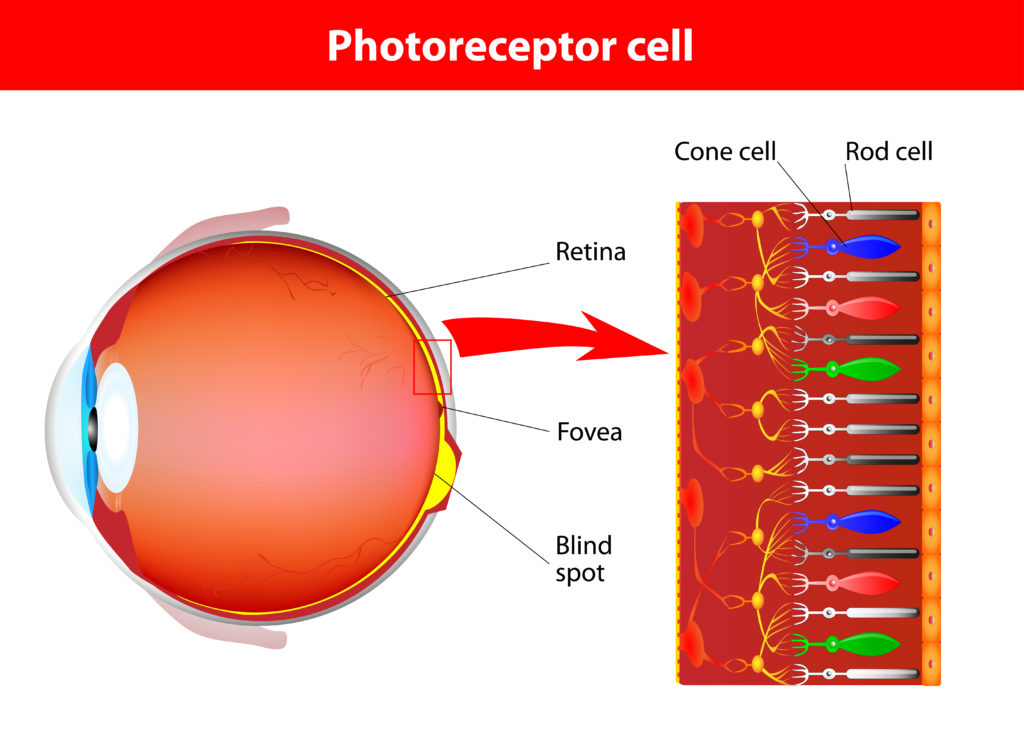Discovery Eye Foundation–supported researchers are closer to a way to detect age-related macular degeneration (AMD) earlier, thanks to a number of collaborations and a recent grant from the National Eye Institute.
Color Vision and Macular Degeneration
 People see color thanks to cone photoreceptors in the macula area of the retina. There are three types of cone photoreceptors that see color: The blue cones distinguish short wavelength light, the green cones see medium wavelength light, and the red cones perceive long wavelength light. The light-sensitive proteins that make possible color perception within these cones are called “opsins.” The genes that make up these opsins allow people to see color, so the genetics of one’s opsins influence how much color a person can see.
People see color thanks to cone photoreceptors in the macula area of the retina. There are three types of cone photoreceptors that see color: The blue cones distinguish short wavelength light, the green cones see medium wavelength light, and the red cones perceive long wavelength light. The light-sensitive proteins that make possible color perception within these cones are called “opsins.” The genes that make up these opsins allow people to see color, so the genetics of one’s opsins influence how much color a person can see.
DEF Research Director Dr. Cristina Kenney was approached about five years ago by Dr. Kimberly Jameson of the Institute for Mathematical Behavioral Sciences at UC Irvine. Jameson is interested in the perception of color vision — specifically how it relates to the genetics of opsins. Since Kenney’s lab is known for studying genetics and AMD, this interest fits perfectly into the lab’s work.
One of the early signs of macular degeneration is the loss of color-vision perception. With the help of DEF funding, together, Kenney and Jameson are looking at patients’ opsins and color vision to determine if they can help develop early diagnostics for people with AMD.
“The DEF funding allowed us to discover the genetic component and allowed Dr. Jameson to develop sophisticated, fast methodologies to analyze a patient’s color vision. Previous methods were quite cumbersome and not appropriate for older adults,” Kenney says. “Now we are able to rapidly obtain DNA from a person and identify opsins from AMD patients to test their genetics to see if opsins are contributing to their AMD.”
Identifying Early Changes to Color Vision
Building on his research and this collaboration, vision scientist Dr. Michael Webster, a foundation professor at the University of Nevada, Reno, obtained a comprehensive 5-year grant from the National Eye Institute to study color deficiencies in individuals. The grant will allow the three researchers to work toward two long-term goals, Kenney says. The first question they hope to answer is: How does an individual perceive color, and what is the basic neural processing from the retina to the brain? The second part is more translational, in that they hope to better understand how people with retinal diseases, such as AMD, process color and determine whether they can identify early changes to color vision.
“With mild or early AMD, there are currently no functional tests to determine if AMD is present,” Kenney says. “Because cone photoreceptors are in the macula, we want to know if we can develop a sensitive color-vision test to diagnose early AMD and correlate it to the genetics, with the eventual hope of preventing AMD progression early in the disease.”
“Without DEF’s funding of the beginnings of this project, we would have never been able to apply for generous government grants to continue this groundbreaking work” Kenney adds.

